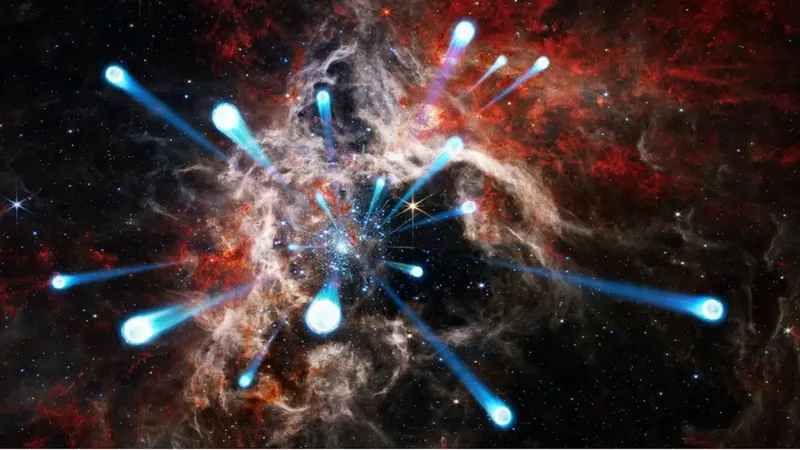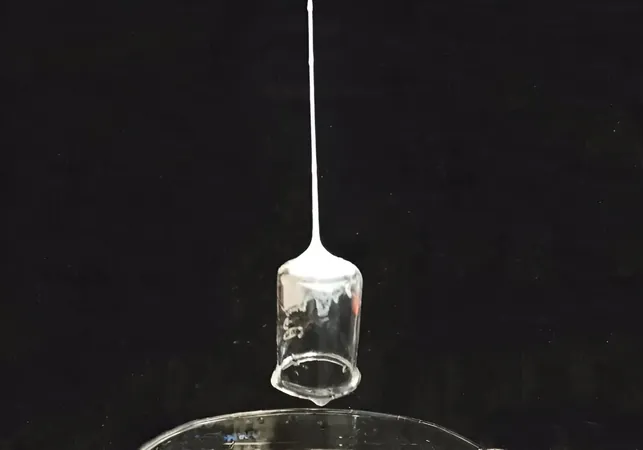
Cosmic Revelation: Gaia Telescope Unveils 55 Runaway Stars Racing Away At Insane Speeds!
2024-10-10
Author: Ying
Groundbreaking Discovery by the Gaia Telescope
Astronomers have made a groundbreaking discovery using the European Space Agency's Gaia space telescope. They've pinpointed **55 runaway stars** that are being ejected from the densely packed R136 star cluster, located in the **Large Magellanic Cloud (LMC)**, our Milky Way's satellite galaxy. This remarkable find marks the first time such a high concentration of stars has been observed escaping from a single star cluster!
The R136 Star Cluster
Situated approximately **158,000 light-years** away, the R136 cluster is a hotbed of stellar formation boasting hundreds of thousands of stars. Among them are some colossal giants that are **300 times the mass of our Sun**!
Speed and Fate of Runaway Stars
The newfound runaway stars are racing through space at mind-boggling speeds, exceeding **62,000 miles per hour (100,000 kilometers per hour)**—around **80 times the speed of sound** on Earth! These massive stars are not just speeding away; their explosive fate will likely lead to spectacular supernova events, potentially transforming them into **black holes** or **neutron stars**. The dramatic blasts could send these remnants as far as **1,000 light-years** away from their origins, acting as cosmic projectiles that can dramatically influence their surroundings.
Leading the Discovery
Leading the charge in this discovery is a team from the University of Amsterdam, headed by researcher **Mitchel Stoop**. Thanks to Gaia's precise tracking of billions of stars, the findings have expanded the tally of known runaway stars by a factor of **ten**.
Why Are Stars Being Flung Away?
But why are these stars being flung into the cosmos? Scientists believe that the chaotic environment within young star clusters like R136—a mere **2 million years old**—causes stars to collide and disrupt each other's orbits gravitationally. What’s particularly fascinating about this study is the realization that R136 has experienced **two major ejection events** in its short lifespan. The first burst occurred **1.8 million years ago** during the cluster’s formation, while the recent surge of runaway stars took place just **200,000 years ago**.
Different Ejection Events
The characteristics of these ejections differ strikingly between the two episodes. The second wave exhibits a more directed escape, suggesting a structured interaction with another nearby star cluster, which was only identified in **2012**. Researcher **Alex de Koter** believes that the two clusters may eventually merge.
The Role of Massive Stars
Historically, massive stars within R136 are more than just impressive; they play a significant role in cosmic evolution. Their immense brightness, especially in ultraviolet light, contributes significantly to the **re-ionization of the universe**, a crucial phase that transitioned our universe from its infancy around **1 billion years old** to a stage that supported the development of normal galaxies.
Implications of the Findings
The latest discovery not only emphasizes the importance of massive stars but also suggests their influence on **galactic structure and evolution** is perhaps more profound than previously understood. As **Lex Kaper**, another researcher on the team, pointed out, the ejected stars challenge our perceptions of stellar dynamics and the universe's evolution.
Gaia's Ambitious Objectives
The primary objective of this ambitious study was to test Gaia’s capabilities as it forges a 3D map of our Milky Way galaxy. With the LMC serving as an ideal testing ground due to its significant distance from Earth, the team is excited about the implications of their findings for our understanding of both R136 and the cosmos.
Conclusion
In conclusion, with every new discovery made by Gaia, we inch closer to unraveling the intricate tapestry of our universe, and the thrill of such monumental findings keeps the scientific community buzzing. Stay tuned, as astronomers continue to explore the mysteries of the stars!




 Brasil (PT)
Brasil (PT)
 Canada (EN)
Canada (EN)
 Chile (ES)
Chile (ES)
 España (ES)
España (ES)
 France (FR)
France (FR)
 Hong Kong (EN)
Hong Kong (EN)
 Italia (IT)
Italia (IT)
 日本 (JA)
日本 (JA)
 Magyarország (HU)
Magyarország (HU)
 Norge (NO)
Norge (NO)
 Polska (PL)
Polska (PL)
 Schweiz (DE)
Schweiz (DE)
 Singapore (EN)
Singapore (EN)
 Sverige (SV)
Sverige (SV)
 Suomi (FI)
Suomi (FI)
 Türkiye (TR)
Türkiye (TR)